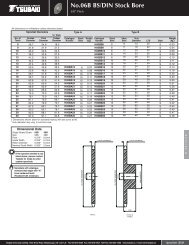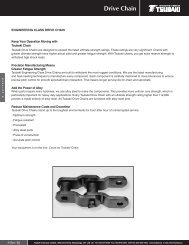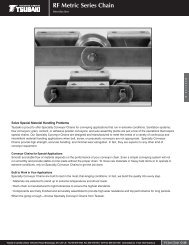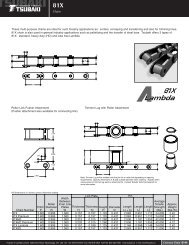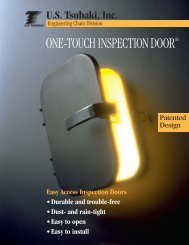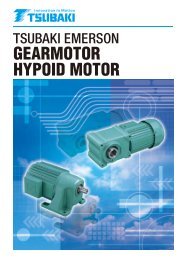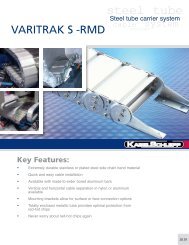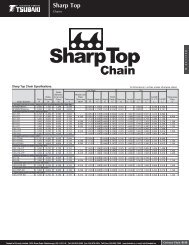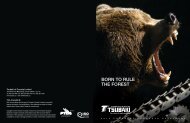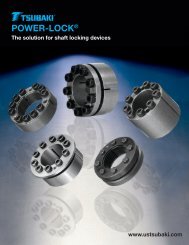Roller Chain - Tsubaki
Roller Chain - Tsubaki
Roller Chain - Tsubaki
Create successful ePaper yourself
Turn your PDF publications into a flip-book with our unique Google optimized e-Paper software.
<strong>Roller</strong> <strong>Chain</strong> Structure2. Assembly Parts<strong>Roller</strong> <strong>Chain</strong>s are usually made up of a number of connected links in an endless formation, or used by fixing the chain ends, but theneed for connecting links will eventually arise. Although offset links can be used when there are an odd number of links in the roller chain,please use a design that requires an even number of links as much as possible.2.1 Connecting LinksM-type Connecting Links (Formerly: Standard Connecting Link)RS <strong>Roller</strong> <strong>Chain</strong>Cotter Pin-typeClip-type Cotter Pin-type Multi-strand (2-strand shown) Spring Pin-type (RS240 only) F-type Connecting LinkClipPin Link PlatePinConnecting Link Plate(RC processing)Cotter PinPinPin Link PlateInner PlateConnectingLink PlateSpringPinPin Link PlatePin Pin PinConnecting Link PlateClipPin Link PlateConnectingLink PlateCotter PinDrive <strong>Chain</strong><strong>Chain</strong> TypePin & Connecting Link PlateFittingConnecting Link PlateFastening MethodPoints to NoteRS <strong>Roller</strong> <strong>Chain</strong>Slip FitPress FitClipCotter PinSpring PinClip / Cotter PinSpring PinT Pin• For multi-strand chain, make sure the plate with ringcoining processing is on the outer most side whenassembling.• Operating speed is indicated by the white area in theHP ratings table.• Make sure to use the chain according to the specifiedapplications on page A-90 and within the speed regionof the colored area in the HP rating tables.Lambda (Λ) <strong>Roller</strong><strong>Chain</strong>SUPER <strong>Roller</strong> <strong>Chain</strong>SUPER-H <strong>Roller</strong> <strong>Chain</strong>ULTRA SUPER <strong>Roller</strong> <strong>Chain</strong>RS-HT <strong>Roller</strong> <strong>Chain</strong>Slip FitPress FitPress FitClipCotter PinSpring PinCotter PinSpring Pin• Can be used in all areas of the HP ratings tablefor Lambda <strong>Chain</strong>.• Ring coining is carried out on the connecting linkplates.• Please use the exclusive connecting links for eachchain type.• Please use the exclusive connecting link for RS-HT<strong>Roller</strong> <strong>Chain</strong>.Heavy Duty <strong>Roller</strong><strong>Chain</strong>Press FitT Pin• There are no connecting links, so use connectingpins for assembly.2.2 Offset Links1 Pitch Offset Links (OL)Single strandOffset Link PlateMulti-strand(2-strand shown)2 Pitch Offset Links (2POL)Single Strand Multi-strand (2-strand shown)1 Pitch Offset LinksWhen an OL is used, please allowfor a 20% reduction in HP ratingscompared to that of the main chainand a 35% reduction in MaximumAllowable Load.PinCotter PinOffset Link PlatePlease refer to the dimension tables for roller chain types and sizes suitable for offset links.2.2 Identical maximum allowable load as main chain…(Slip-fit connecting link and two-pitch offset link)<strong>Tsubaki</strong> ANSI Standard <strong>Roller</strong> <strong>Chain</strong>Main chain 100%Slip-fit connecting link 100%Semi Press-fit connecting link 100%Two-pitch offset link 100%One-pitch offset link 65%Pin2 Pitch Offset linksThe pin and offset link plate of a2POL is press fit and is fastenedby a rivet. They can be used inaccordance with the HP ratingstables.The maximum allowable load on the Slip-fitconnecting link and the two-pitch offset linkhave been improved to the level of the mainchain, thereby allowing full exploitation of thechain’s performance for slow speed chainselection.A-9



